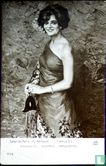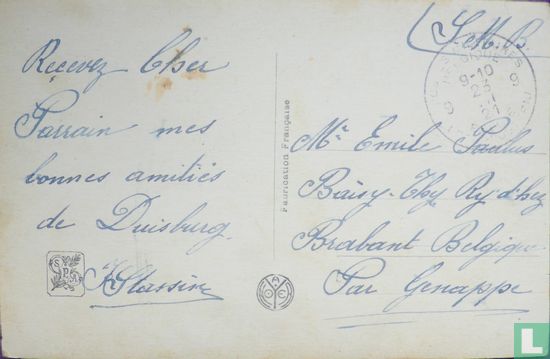Postcard of a print of a Painting of a Transvestite by Jean-Pierre Poitevin, sent by a Belgian soldier stationed in Duisburg, Germany in 1921 Postmark Postes Militaires Belgique Post Office July 23, 1921 text on card recevez cher parrain mes bonnes amities de Duisburg Addressed to Genappe Genepiën Belgium (source wiki; Between 1921 and 1925, Duisburg was occupied by French and Belgian troops to force Germany to pay reparations for the First World War. Jean-Pierre Poitevin was mainly a cartoonist, he also created pastels, oil paintings, watercolors and lithographs . testimonies from the time of the wars (1914-1933) . Exhibitions in Paris, rue St. Honore and Brussels, he drew the major events of his time: the war of 14-18, Daudet trial, Tour de France cyclist, landing by Charles Lindbergh, many Parisian scenes, landscapes of the provincial city of Geneva, Brussels, Bruges ... Born in Chatellerault, son of Jean Poitevin teacher at the Lycee Charlemagne in Paris. Studies: Lycee Charlemagne, Lycee Henri IV, Diploma in Egyptology, Visual arts (painting, sculpture). Lives with his parents rue Sedaine (XII). Between 1912 and 1919, three years of military service and four years of war as a private, he refuses to rise in rank despite the promotions offered, not wanting to be responsible for the deaths of his other soldiers. Realizes the newspaper "Le Rigolboche". Married to Jeanne MAYNAU with whom he had two daughters, Danielle (1914-1988) and Anne-Marie (1920). Upon returning from the war, 28 Quai d'Orleans (Ile St. Louis) lives. Reporter newspaper cartoonist "Daily", "Petit Parisien" and Illustration portraitist notable family works. professor of drawing at the ABC school. passing the last months of his life in Bucharest, where he obtained a position of cultural attache at the Embassy of France. Died in 1933 at the age of 44, leaving some of his work in Romania. Buried in Bucharest, the cemetery and his grave will disappear during Ceausescu's "great work". PS: The publisher of this site is to search all documents and information related to Pierre-Jean Poitevin and his work, he would get in touch with someone with drawings or paintings of the artist, in particular about his story of Charles Lindbergh landing at Le Bourget in 1927. The Paris Salon is a major art exhibition that takes place regularly in Paris. The Salon de Paris or Salon was of great importance for art, especially in the 19th century. The salon, then called l'exposition, was founded in 1648 by Cardinal Jules Mazarin, minister of finance under Louis XIV, and was intended for graduates of the École des Beaux-Arts. From 1673 onwards, the exhibition organized annually (later also biennially) by the Académie royale de peinture et sculpture (which was replaced in 1816 by the Académie des Beaux-Arts), also founded in 1648, took place. In 1725 the exhibition was held in the so-called Salon carré of the Palais du Louvre and was initially called the Sallon. The Salon, as the exhibition was later called, had also been open to the public since 1737. For two centuries it was the most important exhibition for visual artists in France and it was essential for painters and sculptors who wanted to make their name to participate. The strict selection was liberalized after the 1848 revolution and initially fewer artists were refused. The organization of the Salon has been in the hands of the Société des Artistes Français since 1881, when the state withdrew completely as organizer, and the official name was changed to Salon des Artistes Français. The salon was visited by visitors from all walks of life. The salon mainly showed works by established visual artists from the art academy. Newcomers who went their own way, such as Paul Cézanne, were often rejected. If artists' work was refused for the Salon, the possibilities for exhibiting it elsewhere became very limited. The rejected work was marked with a stamp with the letter R (for "refusé", which means refused). But even if the work had been selected, it was still important to get a good place. In the nineteenth century, the entire wall was covered with paintings during an exhibition. Of course, if the work was hung very high, no one could see it. Through letters and requests to the academy's management, the artists tried to get a better place.
This text has been translated automatically from Dutch
Click here for the original text
Postkaart van een prent van een Schilderij van een Travestiet door Jean-Pierre Poitevin ,
verzonden door een Belgische militair gelegerd in Duisburg, Duitsland in 1921
Poststempel Postes Militaires Belgique Leger posterijen 23 Juli 1921
tekst op kaart
recevez cher parrain mes bonnes amities de Duisburg
Geadresseerd naar Genappe Genepiën Belgie
(bron wiki ; Tussen 1921 en 1925 werd Duisburg door Franse en Belgische troepen bezet om Duitsland te dwingen de herstelbetalingen voor de Eerste Wereldoorlog te betalen.
Jean-Pierre Poitevin was vooral cartoonist, hij creerde ook pastels, olieverfschilderijen, aquarellen en litho's.
getuigenissen uit de tijd van de oorlogen (1914-1933). . Tentoonstellingen in Parijs, rue St. Honore en Brussel
tekende hij de grote gebeurtenissen van zijn tijd: de oorlog van 14-18, Daudet proef, Tour de France wielrenner, landing van Charles Lindbergh, vele Parijse taferelen, landschappen provinciale stad Genève, Brussel, Brugge ... Geboren in Chatellerault, zoon van Jean Poitevin leraar aan het Lycee Charlemagne in Parijs. Studies: Lycee Charlemagne, Lycee Henri IV, Diploma Egyptologie, Beeldende kunsten (schilderkunst, beeldhouwkunst). Woont met zijn ouders rue Sedaine (XII). Tussen 1912 en 1919 drie jaar militaire dienst en vier jaar oorlog als een private, weigert hij te stijgen in rang, ondanks de promoties die worden aangeboden, niet te willen verantwoordelijk zijn voor de dood van zijn andere soldaten. Realiseert de krant "Le Rigolboche". Gehuwd met Jeanne MAYNAU wie hij twee dochters, Danielle (1914-1988) en Anne-Marie (1920). Bij terugkomst van de oorlog, leeft 28 Quai d'Orleans (Ile St. Louis). Reporter krant cartoonist "dagelijks", "Petit Parisien" en Illustratie portrettist opmerkelijke familie werkt. hoogleraar tekenen bij de ABC school. passeren van de laatste maanden van zijn leven in Boekarest, waar hij een positie van cultureel attache verkregen bij de ambassade van Frankrijk. Overleden in 1933 op 44-jarige leeftijd, waardoor een deel van zijn werk in Roemenië. Begraven in Boekarest, zal de begraafplaats en zijn graf tijdens het "grote werk" van Ceausescu verdwijnen . PS: De uitgever van deze site is om alle documenten en informatie in verband met Pierre-Jean Poitevin en zijn werk zoeken, zou hij in contact komen met iemand met tekeningen of schilderijen van de kunstenaar, in het bijzonder over zijn verhaal van Charles Lindbergh landing op Le Bourget in 1927.
De Parijse salon is een grote kunsttentoonstelling, die regelmatig in Parijs plaatsvindt. De Salon de Paris of Salon was vooral in de 19e eeuw van groot belang voor de kunst.
De salon, destijds genaamd l'exposition, werd in 1648 opgericht door kardinaal Jules Mazarin, minister van financiën onder Lodewijk XIV, en was bedoeld voor afgestudeerden aan de École des Beaux-Arts. Vanaf 1673 vond jaarlijks (later ook wel tweejaarlijks) de, door de eveneens in 1648 gestichte Académie royale de peinture et sculpture (die in 1816 werd vervangen door de Académie des Beaux-Arts), georganiseerde tentoonstelling plaats. In 1725 werd de expositie gehouden in de zogenaamde Salon carré van het Palais du Louvre en heette aanvankelijk de Sallon. De Salon, zoals de expositie later werd genoemd, was sinds 1737 ook voor het publiek toegankelijk. Gedurende twee eeuwen was het de belangrijkste tentoonstelling voor beeldende kunstenaars in Frankrijk en het was voor schilders en beeldhouwers, die hun naam wilden vestigen, absoluut noodzakelijk er aan deel te nemen.
De strenge selectie werd na de revolutie van 1848 geliberaliseerd en aanvankelijk werden minder kunstenaars geweigerd. De organisatie van de Salon is sinds 1881, toen de staat zich volledig als organisator terugtrok, in handen van de Société des Artistes Français en de officiële naam werd gewijzigd in Salon des Artistes Français.
De salon werd bezocht door bezoekers uit alle lagen van de bevolking. De salon toonde vooral werken van gevestigde beeldende kunstenaars vanuit de kunstacademie. Nieuwelingen die hun eigen weg gingen, zoals Paul Cézanne, werden vaak geweigerd. Als werk van kunstenaars werd geweigerd voor de Salon, werden de mogelijkheden om het elders te exposeren erg klein. Het geweigerde werk werd namelijk gemerkt met een stempel met de letter R (van "refusé", hetgeen geweigerd betekent).
Maar ook als het werk was geselecteerd, was het nog van belang een goede plaats te krijgen. In de negentiende eeuw werd namelijk bij een tentoonstelling de gehele wand volgehangen met schilderijen. Als het werk erg hoog werd opgehangen kon niemand het natuurlijk zien. Door brieven en verzoeken aan de directie van de academie, probeerden de kunstenaars een betere plaats te krijgen.











